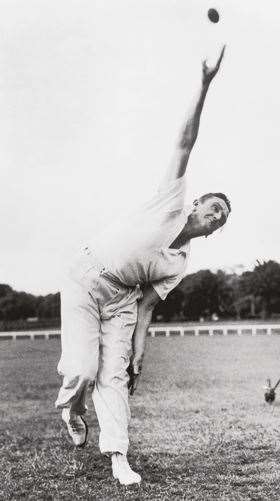Long before Warne, there was Jack Iverson, whose “bent finger” grip changed batsmen’s approach to the trundler forever.
 Long before Warne, there was Jack Iverson, whose “bent finger” grip changed batsmen’s approach to the trundler forever.
Long before Warne, there was Jack Iverson, whose “bent finger” grip changed batsmen’s approach to the trundler forever.
He was a true “shooting star”.
They say John Brian “Jack” Iverson could’ve been anything, with his ability to bamboozle the very best of batsmen. His career was all too brief, and it could be argued – in fact it has been, frequently – that the willow-wielders might’ve worked him out had he remained long enough. In fact, they say that’s why Jack went as quickly as he came ...
It’s doubtful though. Iverson was no mug, and after all, experience cuts both ways. He had the basic tools and cricketing intelligence, and had unlocked and mastered a secret most cricketers didn’t even know existed. Batsmen might’ve worked him
out to an extent, but his amazingly varied gift would’ve enabled him to keep them guessing forever, had he played enough.
Iverson was the original exponent and inventor of the “bent finger” grip. This involved holding the ball between the thumb and middle finger, and bending the middle finger the way a leg spinner might normally bend the ring finger. In effect, only three fingers were used, but guided by the rudder of his thumb, and propelled by the spring of his middle finger, the ball would go exactly where he wanted it to go, and spin in any direction he desired.
It’s an unnatural way for most people to hold a ball, but Iverson found it perfectly natural. In fact, his control using the unorthodox grip was unbelievable, and the range of deliveries he could bowl, and disguise, was peerless.
Furthermore, his grip opened up new possibilities of flight, as the ball didn’t drop sharply onto the pitch as it does with a normal leg break. Iverson wasn’t around long enough to explore all those possibilities, but years later, Johnny Gleeson was able to do so using the Iverson grip.
Jack was 24, serving in the Australian Army in World War Two, when he first developed his unique grip playing in spontaneous recreational matches with his fellow soldiers. Having briefly been a fast bowler at his school, Geelong College, he once dismissed his future Australian and Victorian captain, Lindsay Hassett.
Iverson returned from the war with no intention of playing cricket. For recreation, he pursued golf and tennis, until he met with some blind cricketers at the MCG. Not long after, he felt inspired to wander down to Brighton Cricket Club. It was 1946. At 31 years old, Iverson made an immediate impact.
He described the subtleties of his action very simply: “I woke up to the fact that whichever direction I had my thumb pointing, so would the ball break ... If my thumb was pointed to the left or offside as I let the ball go, the result would be a leg break. If it pointed to the right or leg side, the result would be a wrong ‘un. If it pointed directly at the batsman, it would be a topspinner.”
The small variations to his thumb meant Iverson was able to bowl his array of deliveries without any discernible change to his action. He was a big bloke, and his long and strong fingers were of great benefit.
By 1948, he was playing for the Melbourne Cricket Club, and a year later, he was in the Victorian side, where he took 46 wickets in his first season, averaging 16.12. There followed a tour of New Zealand under Bill Brown, where he captured an amazing 75 wickets at an average of seven.
The next season, at 35, Iverson was selected to play Test cricket, and against England in the 1950-51 series, he did exactly what was expected of him. Overall, he captured 21 wickets at 15.73. It was obvious from the start he was going to be a prolific wicket-taker. He took 4/43 in the second innings of the Brisbane Test after failing to get a bowl in the first innings. He got match figures of 6/73 in Melbourne, then took 6/27 in the second innings of the Test in Sydney.
No one is sure whether the ankle injury he suffered in Adelaide after treading on a ball contributed to his sharp decline. He took 3/68 and 2/84 in his last two Tests, and only played one game in each of the next two seasons. In the end it was his father’s illness that put paid to Iverson’s cricketing career. Jack felt obliged to help him keep the family business, a real estate agency, afloat. He did briefly resurrect his career in 1953-54, when he played a match for an unofficial Australian team.
In 1973, after years of depression caused, they say, by atherosclerosis of the brain, Iverson committed suicide by shooting himself in the chest. He was 58.
He played cricket long enough to impress the wiliest of spin bowlers, and Richie Benaud ranked him with another of our Innovators, Bernard Bosanquet, and Gleeson and Warne, as a bowler who changed the way batsmen viewed the trundler forever.
– Robert Drane
Related Articles

Feature Story: Moving the Needle

The Aussies at The Open













